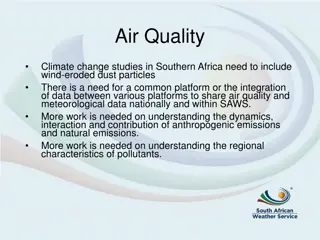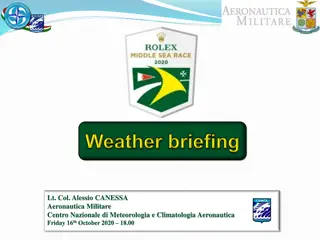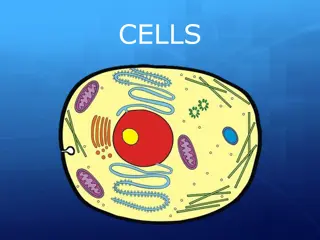The Life Stages of Individual Cells in Thunderstorms
The stages of life of individual cells in thunderstorms progress from the Cumulus Stage with powerful updrafts, to the Mature Stage where precipitation forms, and finally to the Dissipating Stage as downdrafts weaken. Air Mass Thunderstorms are described as non-frontal and typically form in warm, moist air masses due to diurnal heating. A second form of air mass thunderstorm is created by cold advection.
Uploaded on Sep 09, 2024 | 0 Views
Download Presentation

Please find below an Image/Link to download the presentation.
The content on the website is provided AS IS for your information and personal use only. It may not be sold, licensed, or shared on other websites without obtaining consent from the author. Download presentation by click this link. If you encounter any issues during the download, it is possible that the publisher has removed the file from their server.
E N D
Presentation Transcript
The stages of life of individual cells are: (a)Cumulus Stage : The cumulus stage is marked by updrafts only. These updrafts can reach values of up to 3,000 feet per minute and cause the cloud to build carrying super cooled water droplets well above the freezing level. . rapidly upwards,
(b) Mature Stage The appearance of precipitation beneath the base of the cell and the development of the downdraft mark the transition to this stage. The downdraft is caused by water drops which have become too heavy for the updraft to support and now begin to fall.
At the same time, the drops begin to evaporate as they draw in dry air from the edge of the cloud, and then fall through the drier air beneath the base of the cloud. This evaporation causes the air to cool and become denser, resulting in a downwash of accelerating cold air. Typical downdraft speeds can reach values of 2,500 feet per minute
(c) Dissipating Stage The dissipating stage of a cell is marked by the presence of downdrafts only. With no additional flow of moisture into the cloud from an updraft, the rain gradually tapers off and the downdrafts weaken. The cell may dissipate completely in 15 to 30 minutes, leaving clear skies or patchy cloud layers. At this stage the anvil, which is formed almost exclusively of ice crystals, often detaches and drifts off downwind.
Types of Thunderstorms (a) Air Mass Thunderstorms These thunderstorms form within a warm, moist air mass and are non-frontal in nature. They are usually a product of diurnal heating, tend to be isolated, reach maximum strength in the late afternoon, are seldom( ) violent( and usually dissipate quickly after the setting of the sun. , (
There is also: a second form of air mass thunderstorm that is created by cold advection. In this case, cold air moves across warm land or water and becomes unstable. Of these two, it is the movement of cold air over warm water that results in the most frequent occurrence thunderstorm. Since the heating thunderstorms can form at any time of day or night. of this type of is constant, these
(b )Frontal Thunderstorms These thunderstorms form either as the result of a frontal surface lifting an unstable air mass or a stable air mass becoming unstable, as a result of the lifting. Frontal thunderstorms can be found along cold fronts and warm fronts .
These numerous in the area, often form in lines, are frequently embedded in other cloud layers, and tend to be active during the afternoon and well into the evening. Cold frontal thunderstorms are normally more severe than thunderstorms thunderstorms tend to be warm frontal
(c) Squall Line Thunderstorms A squall line (or line squall) is a line of thunderstorms. Squall lines can be several hundred miles long and have lower bases and higher tops than the average thunderstorm. Violent combinations of strong winds, hail, rain and lightning make them an extreme hazard not only to aircraft in the air, but also to those parked uncovered on the ground.
Squall line thunderstorms are most often found 50 to 300 miles ahead of a fast-moving cold front but can also be found in accompanying low pressure troughs, convergence, along ranges and even along sea breeze fronts. in areas mountain of
(d) Orographic Thunderstorms Orographic thunderstorms occur when moist, unstable air is forced up a mountain slope. These are common in the foothills of the Rocky Mountains where, on a typical summer day, they combination of upslope flow and daytime heating . When they get high enough, the prevailing west southwest flow aloft carries them eastwards. form due to a
If conditions are favorable, they can persist for several hours, otherwise they dissipate fairly rapidly. Typically, they will begin to develop in mid- morning and can continue to form well into the afternoon. In such situations, these storms frequently produce copious amounts of hail.

















































